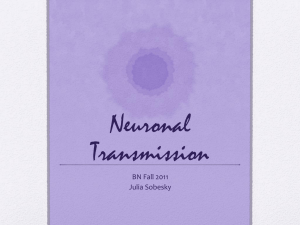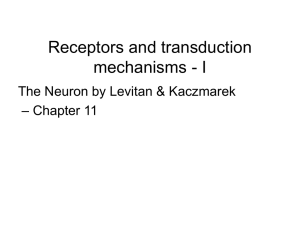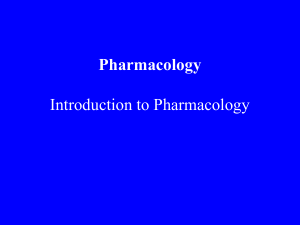Mechanisms of drug action
advertisement
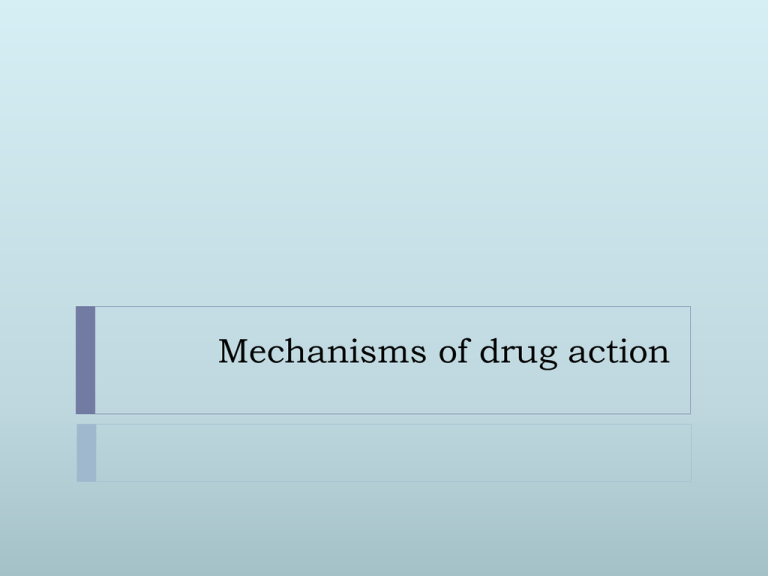
Mechanisms of drug action pharmacodynamics What the drug does to the body This illustrates on the process of which drug alters the body environment, either by interfering with hormones, receptors, enzymes or other macromolecules Mechanisms of drug action Drugs acting on cell membranes Drugs acting on metabolic processes within the cell Drugs acting outside the cell Drugs acting on cell membrane Acting on receptors on cell membrane –agonists and antagonists Interference with selective passage of ions across the cell membrane Inhibition of membrane bound enzymes or pumps Drugs acting on cell membrane receptors What is a cell membrane receptor? A macromolacular complex that is embedded in the cell membrane and functions to receive chemical information from the extracellular compartment and to transmit that information to the intracellular compartment. Receptor down regulation When a receptor is continuously exposed to an agonist the number of receptors decrease This is known as receptor down regulation Ex- nitrates given for angina looses its effect with time Receptor up regulation Pronged contact with antagonist results in formation of new receptors Ex-suddern withdrawal of B blockers lead to worsening of angina /arrythmi Abrupt withdrawal of the drug lets circulatory NA and A having access to the up regulated receptor number Antagonists • • Some drugs bind to cell surface receptors, but do not activate the receptors to trigger a response. • When cell surface receptors bind the drug , the endogenous chemical cannot bind to the receptor and cannot trigger a response. • The compound is said to “antagonize” or “block” the receptor and is referred to as a receptor antagonist. example β1 receptors are a sub group of adrenoceptors. Endogenous adrenaline and nor adrenaline act on these receptors in heart and increase heart rate and cardiac contractility there by increasing the cardiac work load and the blood pressure. Propranolol is a β receptor antagonist. It binds to β1 receptors and block NA and adrenaline binding, there by lowering cardiac contractility and BP HOW DO DRUGS WORK BY ANTAGONIZING CELL SURFACE RECEPTORS? Extracellular Compartment Unbound Endogenous Activator (Agonist) of Receptor Cell Membrane Inactive Cell Surface Receptor Intracellular Compartment HOW DO DRUGS WORK BY ANTAGONIZING CELL SURFACE RECEPTORS? Extracellular Compartment Bound Endogenous Activator (Agonist) of Receptor Cell Membrane Active Cell Surface Receptor Intracellular Compartment Cellular Response HOW DO DRUGS WORK BY ANTAGONIZING CELL SURFACE RECEPTORS? Displaced Endogenous Activator (Agonist) of Receptor Extracellular Compartment Bound Antagonist of Receptor (Drug) Cell Membrane Inactive Cell Surface Receptor Intracellular Compartment Agonists • • Some drugs bind to cell surface receptors, and activate the receptors to trigger a response. • The compound is said to “agonize ” the receptor and is referred to as a receptor agonist. Example The bronchioles have B2 receptors. Adrenaline act on them to cause bronchiodilatation. In asthma, the bronchioles constrict giving rise to breathing difficulty The drug used,salbutamol is a B2 receptor agonist that bind B2 receptors and act on them to cause bronchodilatation Partial agonists Some drugs,which block the receptors and prevent natural ligands bind can also have a mild stimulating effect on the receptor as well. So they have both agonist and antagonist actions Receptor binding Some drugs bind receptors with weak bonds.(hydrogen bonds,van der Waals bonds etc.)this type of binding would be rapidly reversible and can be displaced by increasing the endogenous substance concentration. Some drugs bind receptors with strong bonds (covalent bonds)and then the binding would be irriversible Receptor binding Irreversible antagonism-The drug phenoxybenzamine is an alpha receptor blocker. In a condition where there is a tumor of the adrenal gland which releases adrenaline(pheochomocytoma), this drug is given during surgery The reason is that during surgery, high amounts of adrenaline is released to the circulation Adrenaline can bind to alpha receptors to increase the blood pressure To prevent this a drug that can block the alpha receptors are used However if a reversible alpha antagonist is used, it can get displaced by high adrenaline levels,and to avoid this an irreversible alpha receptor blocker is used Physiological antagonism Drugs might not always act on the same receptor which a physiological substance binds, in order to counteract its action, Anaphylactic shock is a condition where due to an allergy, mast cells are activated and releases histamine which acts on histamine receptors to cause bronchoconstriction The drug adrenaline is given as treatment and it acts via a different receptor,the beta 2 adrenoceptor to cause bronchodilatation. Drugs acting on cell membrane Acting on receptors on cell membrane –agonists and antagonists Interference with selective passage of ions across the cell membrane Inhibition of membrane bound enzymes or pumps Interference with selective passage of ions across the cell membrane Calcium channel blockers Calcium is needed for muscle contraction.CCB drugs act on the vascular smooth muscle and block the calcium transport, preventing contraction of vascular smooth muscle. This causes vasodilatation and lowering of blood pressure Inhibition of membrane bound enzymes or pumps Cardiac glycosides interfering with the Na+ K+ ATPase pump of the heart muscle which causes Na+ to accumulate within the myocardium.This Na+ is exchanges to Ca2+, so the calcium increases in myocardium increasing contractility of the heart muscle Drugs acting on metabolic processes with in the cell Enzyme inhibition Inhibition of transport process that carry substances across cells Incorporation of larger molecules Altering other metabolic processes Enzyme inhibition Some important drugs act as enzyme inhibitors Inhibition caused by drugs may be either reversible or irreversible. Drug binds to the enzyme by weak bonds in reversible inhibition Example for competitive enzyme inhibition Angiotensin II is a very potent chemical that causes rise in BP. Angiotensin II is formed from angiotensin I by the enzyme angiotensin converting enzyme (ACE). ACE inhibitors are medications that slow (inhibit) the activity of the enzyme ACE, which decreases the production of angiotensin II. As a result, the blood vessels dilate, and blood pressure is reduced. Inhibition of transport process that carry substances across cells Blocking anion tansport of renal tubule by probenacid can be used to delay excretion of penicillin Incorporation of larger molecules Some Anticancer drugs mimic nucleotides and bind the nucleotide chains inhibiting DNA synthesis Drugs acting outside the cell Direct chemical interactions Ex- antacids- MgOH is an antacid. In patients with gastritis MgOH when given orally neutralizes the acids in the stomach, with out getting absorbed into cells Osmosis Ex-magnisium sulphate is a laxative which is given to treat constipation. It is a molacule that is not absorbed into the GIT and remains in the gut.It holds water, so stools become bulky and constipation is relieved Terminology…. Affinity—tendency of a drug to combine with a receptor, to produce drug receptor complex and maintain it. There is always affinity constant for specific receptors. Affinity may vary—it ↑ when the receptor is vacant and ↓ when the receptor is occupied. Selectivity Is the ability of the drug to produce the expected action,with out giving rise to unwanted side effects potency The amount of drug in relation to its effect Ex- if Xmg of drug A has more effect than the same weight of drug B , drug A is said to be more potent Lethal dose A lethal dose (LD) is an indication of the lethality of a given substance. Because resistance varies from one individual to another, the 'lethal dose' represents a dose (usually recorded as dose per kilogram of subject body weight) at which a given percentage of subjects will die. Animal-based LD measurements are a commonly-used technique in drug research.. LD values for humans are generally estimated by results from testing on animals on human cell cultures Toxic dose the dosage that may be expected to cause a toxic effects in majority of the patients to whom it is given. ED50 - Median Effective Dose 50; the dose at which 50 percent of the population or sample manifests a given effect; used with quantal dr curves TD50 - Median Toxic Dose 50 - dose at which 50 percent of the population manifests a given toxic effect LD50 - Median Toxic Dose 50 - dose which kills 50 percent of the subjects The ‘therapeutic index’ Toxic dose Therapeutic dose Toxic dose Therapeutic index = Therapeutic dose Thank you……

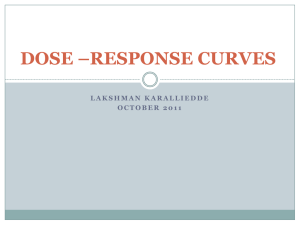
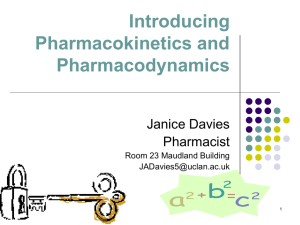
![Shark Electrosense: physiology and circuit model []](http://s2.studylib.net/store/data/005306781_1-34d5e86294a52e9275a69716495e2e51-300x300.png)
